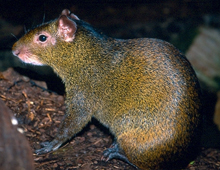Description: The Central American agouti is similar in body shape to guinea pigs, however, the legs are longer. Dorsally, the coat ranges from pale orange to several shades of brown or blackish; ventrally, yellowish to white. The rump is a contrasting color. In some individuals, inconspicuous stripes may be present. The fur of the agouti is coarse, yet glossy. The tail is very small.
Size: Males and females are similar in size, reaching two feet (6.1 m) in length and weighing up to nine pounds (4 kg).
Behavior: The basic social unit of the agouti is made up of a pair that mate with one another for life. Agoutis are diurnal and terrestrial. They will hold fruit in their front paws while eating. They are fast and agile – moving by walking, trotting, galloping and jumping. They spend much of their time grooming.
Diet: Agoutis feed primarily on fruits and nuts. When eating, it often sits on its hind legs and holds the food in its front paws (much like a squirrel).
Senses: Central American agoutis have very good vision and a highly developed sense of smell.
Communication: When alarmed, agoutis will give a sharp bark like a small dog. They will stamp their feet as a threat display.
Reproduction: Central American agoutis breed throughout the year but the majority of offspring in
the wild are born between March and July. The gestation period is between 104-120 days, with litter normally possessing two young. The female has one or two litters each year.
Habitat/range: Central American agoutis inhabit undergrowth of rainforests and savannas from the states of Tabasco and Chiapas in southern Mexico to southern Bolivia and northern Argentina; usually found near water.
Status: IUCN – Least Concern; CITES – Appendix III.



